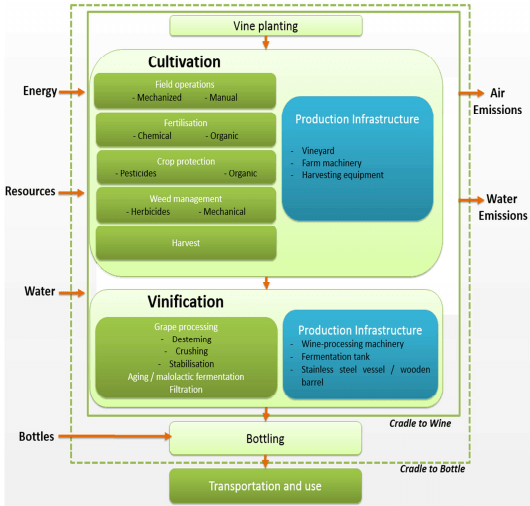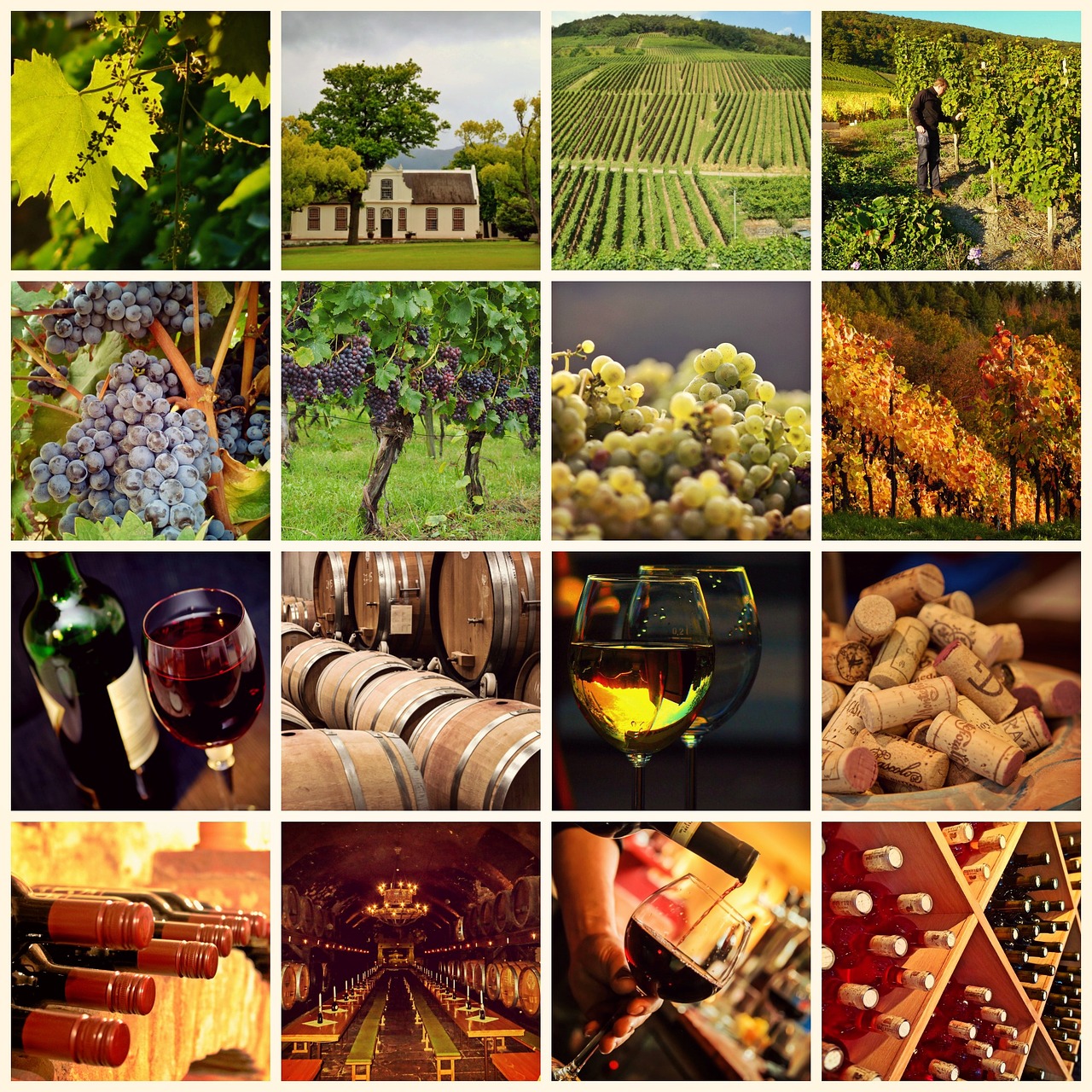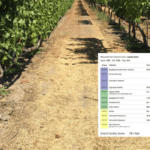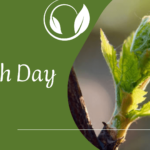Agriculture has a big influence on the environment, it contributes to climate change and global warming. With the use of fertilizers, pesticides, soil, land, water, and energy it’s responsible for approximately 20% of all greenhouse gas emissions. And wine production is no exception, the process of growing grapes and transforming it into wine, contributes to those effects as well.
With the method called life cycle assessment (LCA), the environmental impact of different products life cycle can be assessed and compared. In this article, we are presenting some highlights of wine LCAs.
Life cycle assessment (LCA) is a method to assess environmental impacts of a product life cycle from cradle to grave, namely from raw material extraction through manufacture, and use to the very end – either disposal or recycling.
LCA method was made to analysis industrial production system impact on the environment, but in recent years it has also been used to assess the environmental impact of agricultural products.
Consumption of energy in all stages of the product life cycle, in addition to some other processes, contributes to greenhouse gas emissions.
Greenhouse gas (GHG) emission are emissions of various gasses, such as carbon dioxide, methane, nitrous oxide, fluorinated gasses, which have a negative impact on the climate. Due to the simplified understanding greenhouse gas emissions are converted to CO2 equivalents.
And this is how we get to the term “Carbon footprint”, which is defined as “the total set of greenhouse gas emissions caused by an individual, event, organization, product expressed as CO2e.”
To determine the environmental footprint of an agricultural product, the analysis of individual product life cycle has to be addressed. The life cycle of wine production is divided into the next stages: production, transport, storage, processing and the end of the product life cycle – consumption. The detailed process of grape cultivation and winemaking is presented in figure 1. together with the environmental indicators of wine production.

The life cycle of wine is organized into four main stages:
(1) cultivation – vineyard,
(2) vinification – winery,
(3) bottling – packaging, and
(4) transport.
Most of the studies find that there are two main phases in wine production which produce the most CO2e emissions – the production of glass bottles in the phase of wine bottling and fuel production and combustion (use of machinery) in the vineyard, especially in the vine planting phase.
Studies that compared the life cycle assessment according to different agricultural techniques used in the wine sector – conventional, integrated and organic came to rather interesting conclusions.
In view of the LCA, the organic system shows the worst environmental performance. This result seems a little odd since organic production is known as environmentally friendly.
According to the literature, the conventional system is supposed to have the highest negative impact on the environment. Mainly due to the use of mineral fertilizers and herbicides, as well as the more repeated use of pesticides in comparison with other systems. In organic system, mineral fertilization and herbicides uses are forbidden, while plant protection products usage is very limited. Compared with the integrated production, the use of plant protection products in organic system is lower by 20-50%. However, more frequent use of tractors in organic production results in higher greenhouse gas emission and higher energy consumption. Also, lower yields in organic production contributes to the highest amount of CO2e on a tone of a crop – grapes.
The best results in the view of LCA shows integrated system, while conventional is somewhere in between.
When comparing emissions of CO2e/t crop among the different size of the wineries (small, medium, large), emissions are declining with the size of a farm. The bigger the farm, the lower the emission. Emissions from small farm increased due to the use of the tractor aggregates with less power, which is less energy efficient compared to the tractor aggregates of greater power; moreover, there is more lineal in mechanical tasks on a small workspaces.
Why the need for LCA?
LCA allows identifying the differences in environmental impact between different systems. It also shows the overwhelming importance of the manufacturing steps of materials (tractors, tools, etc.) and inputs (fuel, pesticides, fertilizers) in wine production, as well as any other agricultural production.
Wine-growers might wonder why is it important for them to know the CO2e level they produce in the winery. For start being an environmentally friendly winery is a big plus in promoting and selling wines. And on the other hand knowing winery bottlenecks allows production optimization – reduces the consumption of energy, water, pesticides and save money.
Most wineries have room for improvements in:
- packaging, in particular production of glasses bottles,
- vineyard field emission – use of nitrogen fertilizer and use of machinery
- distribution of wine, i.e. transportation, and
- electricity usage
Sources:
- What is a carbon footprint?; Carbon trust
- California Wine’s Carbon footprint, CSWA, 2011
- Graziella Benedetto. 2013. The environmental impact of a Sardinian wine by partial Life Cycle Assessment. Wine Economics and Policy, Volume 2, Issue 1, June 2013, Pages 33-41, ISSN 2212-9774, https://doi.org/10.1016/j.wep.2013.05.003.
- ENVIRONMENTAL FACTSHEET: Wine, European Commission, 2015 (Torres De Matos, C., Cristobal Garcia, J., & Aurambout, J.-P. (2015). Environmental Sustainability Assessment of Bioeconomy Products and Processes – Progress Report 1. European Commission, Joint Research Centre, Institute for Environment and Sustainability. https://doi.org/10.2791/252460)
- Jejčič Viktor. 2013. Okoljski odtis kmetijstva in živilsko predelovalne industrije ter tehnološki ukrepi za njegovo znižanje v prihodnosti. Institut “Jožef Stefan”, Kmetijski inštitut Slovenije.
- Defining Life Cycle Assessment (LCA); US Environmental Protection Agencc, 2010






10 responses to “Impact of wine production life cycle on the environment”
Hi Urska, I think that a more complete assessment would include degradation to soil health, structure and biodiversity- this will give a more accurate snapshot of the LCA long-term, because there is so much carbon sequestered in healthy soils. I can see the process that’s been used here but I think that there’s a lot more that needs to be taken into account.
Hello Lou, thanks for your comment. Indeed soil degradation could be added to the LCA. When I was researching the topic I wasn’t able to find more comprehensive grapevine life cycle assessment research, if you have any, please share a link/title I’ll be happy to look into it and learn something new.
I live in an area in Oregon that has seen much of the land around me cleared and removed of all native trees and Native species to make room for Vineyards. I think the removal of the trees to make room for the Vineyards should be a big impact. to remove the Oregon rain forest that create oxygen to replace them with Vineyards doesn’t seem right. Also All The Vineyards around me put up massive deer fences for miles and the deer no longer can travel through these areas creating bad situations for the wild life.
Hello Aaron, yes I agree with you, removal of trees have a big impact on the environment for sure. The LCA studies are created in a way that the majority of vineyard across the globe can relate to it, or vineyards of a certain area the LCA study is made for. Not everywhere trees are cut to make space for vines, there are also areas that were completely abandoned but with establishing vineyard they got a new life. The same goes when winegrowers are simply replacing vines for example. But yes I understand your concern, there are always two sides of the story.
Would cattle and dairy have more or less impact than vineyards?
Hi Don, thank you for your question. The livestock is one of the biggest contributor of greenhouse gas emissions, therefore have a bigger impact on the environment than vineyards, for sure. Not sure if it’s right to compere this two AG verticals doe.
Hello Urska, very interesting,
I am wondering if you can point on some measurements of biogeochemical part of the LCA – do you know if there literature on soil N2O/CH4 emissions from the vineyards?
Hello Ilya, I will send you some literature to your email. BR Urska
Hello Urska,
This was very informative – I appreciate all the information about LCA calculations for wineries. I’m curious, though, that winery waste, which has extremely high BOD, is not included in the assessment. Release of untreated winery waste (accidental or otherwise) can cause extreme damage to local soil and water resources. In fact, if winery waste enters surface waters, the damage can extend for hundreds and even thousands of miles downstream in the form of fish kills, toxic algae blooms, and destruction of aquatic ecosystems. Do you think these types of environmental effects should be accounted for in LCA calculations?
Hello Kirsten, thank you for your comment. Yes, it would be very beneficial if the winery waste were included in the analysis since air and water emissions from the vineyards are also included. Please check this article’s source for a detailed overview of each LCA assessment that was made and used for this article. This article was written in 2016; by now, new findings on the topic are available, especially as the carbon footprint is right now a very hot topic in the agriculture industry, especially viticulture.